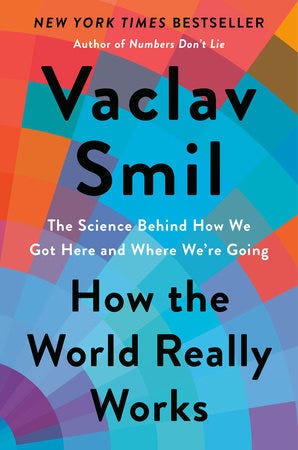The next secular investment opportunity: it’s not all about AI
Why AI alone won’t save the world, and the importance of investing in energy (and energy transitions)
We live in an era where the Prime Minister of Britain and and an American tech billionaire are both being interviewed by… tech! Feels like we are ushering a new era of technology, and it seems to be all the rage lately.
In case you missed it, here is the quick segment below:
Artificial intelligence (AI) has been touted as a potential solution to many of the world's problems, from climate change to poverty and inequality. However, while AI certainly holds great promise and potential, it is far from a panacea that will single-handedly "save the world."
I am certainly a believer in the potential, yet everywhere I look, I cannot help but re-evaluate my optimism with a healthy dose of skepticism. I am a student of bond investing after all aka sell fear, buy bonds.
There are several reasons why AI is unlikely to be humanity’s salvation.
First, AI is only as good as the data and algorithms it is trained on. While AI can process and analyze vast amounts of data much faster and more accurately than humans can, it is still limited by the quality and bias of the data it is fed. If an AI system is trained on biased data, it will produce biased results, perpetuating and amplifying existing inequalities.
In addition, AI is not a self-contained solution that can be applied to a problem in isolation. AI systems must be integrated into existing systems and processes, which can be a complex and time-consuming process. For example, an AI system designed to optimize energy use in a building may reduce energy consumption, but it may also negatively impact the comfort and well-being of the people who live or work there.
Finally, AI is not a magic bullet that can solve all problems. How is that a third point? Take the case of society, AI cannot solve complex social and political issues, such as poverty, inequality, and conflict, which require a much more comprehensive and multi-faceted approach.
So while AI holds great promise and potential, it is far from a panacea that will save the world on its own.
After all, I don’t see ChatGPT making food and drinks…
“OK but Jean, there has been A LOT of money flowing in tech, so let’s go with the flow”
Which brings me to my next piece. The last decade+ has witnessed extraordinary fiscal and monetary stimulus. All sorts of strategies sprung up from this, notably the ever-sprouting number of venture capital funds.
And what do venture capitalists love? SaaS businesses!
Why? Because it’s capital light and high margin -> hooray!
What’s the catch? Well, the monetary stimulus, aka free money is gone, it’s been the hardest fundraising environment in the last decade… which means…
Party’s over tech bros (yes unfortunately, there are way too little women and too little female-founded venture-backed businesses out there – see stats here).
Check out this chart courtesy of Clocktower. I find it rather compelling:
“OK Jean, so what horse are we supposed to back now?”
There is no easy way to say this: to invest in the future of humanity, we must recognize that humanity itself is increasingly dependent on fossil fuels: the most important factor in explaining the advances of modern civilization. It is this notion that also anchors our underlying concerns about the vulnerability of their supply, and of course the environmental impact of their combustion.
Energy conversions are the very basis of life and evolution, not tech. Modern history can be seen as an unusually rapid sequence of transitions to new energy sources, and the modern world is the cumulative result of their conversions.
It’s a pretty harsh reality, right?
I know, as a wildlife enthusiast, water-sports junkie and lover of marine life – it’s a hard reality. I want nothing more than to preserve this incredible plant we call Earth for future generations. And yet, in order for that to work, we need to funnel more capital and innovation towards energy investments and the energy transition.
“But Jean, tech is the future, it’s sexy and we are going to get to wear headsets and live in the metaverse! It’s sexy to work in tech, we get free gluten-free cookies from our cafeteria”
Pop quiz:
How do you order your taxi? Phone!
How does it arrive? Car / petrol.
How do you order your food? UberEats/Deliveroo!
How does it arrive? Human driver or rider.
How do you go on holiday? Book online and Booking.com!
How do you actually get there? Plane / jet fuel.
How do you eat vegan? Shop at WholeFoods!
How is the food made? Five tablespoons of diesel fuel per medium- sized (125 gram) tomato… seriously! Keep reading…
And here lies the problem.
Most of us modern city-dwellers are so disconnected not only from the ways we produce our food but also from the ways we build our machines and devices. The growing mechanization of all productive activity means that only a very small share of the global population now engages in delivering our civilization’s energy, and the materials that comprise our modern world.
“The real wrench in the works: we are a fossil-fueled civilization whose technical and scientific advances, quality of life, and prosperity rest on the combustion of huge quantities of fossil carbon, and we cannot simply walk away from this critical determinant of our fortunes in a few decades, never mind years. Complete decarbonization of the global economy by 2050 is now conceivable only at the cost of unthinkable global economic retreat, or as a result of extraordinarily rapid transformations relying on near-miraculous technical advances.” – Vaclav Smil
In short, for decades it will be impossible to adequately feed the planet without using fossil fuels as sources of energy and raw materials.
Don’t just take my word for it, ask this guy. Our societies are sustained by materials created by human ingenuity, focusing on what Vaclav Smil calls the four pillars of modern civilization:
Ammonia, Steel, Concrete, and Plastics.
His book, How the World Really Works, is an eye-opening read. Even for me, sun and wind lover – convinced that both can supply us with enough energy if we can harness it appropriately – was surprised by the scale of the task at hand when it comes to energy transition.
“Ugh Jean, so dramatic, I am vegan, I eat gluten and so I am doing my part for the planet.”
Cool. Well, technically you’re right.
Altogether it takes about 10 minutes of human labor to produce a kilogram of wheat, and that would, with wholegrain flour, yield 1.6 kilograms (two loaves) of bread. This is laborious, slow, and low-yielding farming, but you’re right it is completely solar, and no other energy inputs are required beyond the magical sunshine (assuming you don’t live in England that is…).
You got 10minutes? That is the trillion-dollar dilemma. Because in about two centuries, the human labor to produce a kilogram of wheat was reduced from 10 minutes to less than two seconds.
This is how our modern ‘world really works’. Let me unpack this thanks to Vaclav…
“Growing the grain, milling it, and baking a 1-kilogram sourdough loaf requires an energy input equivalent of at least 250 milliliters of diesel fuel, a volume slightly larger than the American measuring cup. For a standard baguette (250 grams), the embedded energy equivalent is about 2 tablespoons of diesel fuel; for a large German Bauernbrot (2 kilograms), it would be about 2 cups of diesel fuel (less for a wholewheat loaf).” 🍞
As the French would say about their baguettes – Sacré Bleu!
“Hah, nice try Jean but you ever heard of ‘No Carbs before Marbs’? Marbella or not, I’m more of a protein guy”
Are you that guy who has chicken for breakfast, lunch and dinner because you just benched 100kg at Equinox this morning before going to the office?
Well, producing one American chicken (whose average edible weight is now almost exactly 1 kilogram) needs 3 kilograms of grain corn. And corn, amongst other vegetables, have a stunningly high embedded production and transportation energy cost.
Let’s take a trip up to Northern Europe.
“If you’re Scandinavian (who are excellent at managing / recycling waste) and reading this (disapprovingly no doubt), consider that the tomatoes you buy from your Scandinavian supermarket, tomatoes from Spain’s heated plastic greenhouses. Their transportation and production cost is equivalent to about 650 mL/kg, or more than five tablespoons (each containing 14.8 milliliters) of diesel fuel per medium- sized (125 gram) tomato…” 🍅
I told you so above!
“Wow Jean, you just had a dig at Greta Thunberg right there… and she is feisty!”
First of all, Greta if you’re reading this, you’re great for raising awareness and I respect you for your commitment to the cause.
However, if Greta shouts at you for not doing enough, or someone smears a historical painting at a British Museum with black tar, telling you to stop fossil fuel production – maybe you can take them out to dinner and collaborate on a TikTok video.
Here’s the script.
You can stage, easily and without any waste, a tabletop demonstration of the fossil fuel subsidy, by slicing a tomato, spreading it out on a plate, and pouring over it six tablespoons of dark oil (sesame oil replicates the color well, in case you’re looking).
When sufficiently impressed by the fossil fuel burden of this simple food, you can transfer the plate’s contents to a bowl, add two or three additional tomatoes, some soy sauce, salt, pepper, and sesame seeds, and enjoy a tasty tomato salad.
How many vegans enjoying the salad are aware of its substantial fossil fuel pedigree? Honestly, I wasn’t, at least not that to that extent…
“OK Jean I said protein and you mentioned chicken, I’m a pescetarian and it’s part of my longevity Mediterranean diet”
The Mediterranean diet is legitimately great for longevity, but all jokes aside.
If you want to eat wild fish with the lowest-possible fossil carbon footprint, stick to sardines. I know that’s a big ask, but check out these stats from Smil’s book:
“The mean for all seafood is stunningly high: 700 mL/kg (nearly a full wine bottle of diesel fuel), and the maxima for some wild shrimp and lobsters are, incredibly, more than 10 L/kg (and that includes a great deal of inedible shells!
The energy costs of growing Mediterranean sea bass in cages (Greece and Turkey are its leading producers) are commonly equivalent to as much as 2–2.5 liters of diesel fuel per kilogram (a volume about the same as three bottles of wine)—that is, of the same order of magnitude as the energy costs of capturing similarly sized wild species. As expected, only aquacultured herbivorous fish that grow well consuming plant-based feed —most notably, different species of Chinese carp (bighead, silver, black, and grass carp are the most common)— have a low energy cost, typically less than 300 mL/kg.”
Btw, it’s not like there is a quick fix for this like we have in our diets – aka fasting. We can’t fast our way into saving the planet, or go back to our hunter-gatherer roots because even if even if we were willing to empty our cities and embrace mother earth, humanity could still produce only enough food to sustain less than half of today’s global population.
“God Jean, say something encouraging – is there a natural light at the end of that tunnel or is that luminance also costing us?“
Absolutely, the good news is that we are making some significant progress on both solar and wind. There are also promising prospects for geothermal energy, but that’s a topic for another day (I am still trying to learn more about that myself).
And yet, we’ve been deceived in my view, perhaps by our political leadership, as to how significant these advances were, and how much more is needed. We’ll need to invest more in energy in order to unlock exponential advances needed for our energy transition.
I like to use European examples to illustrate this, primarily because the continent has historically been at the forefront of renewable energy. Let’s look at Germany in this case:
“During the first two decades of the 21st century, Germany’s unprecedented quest for decarbonization (based on wind and solar) succeeded in boosting the shares of wind- and solar-generated electricity to more than 40 percent, but it lowered the share of fossil fuels in the country’s primary energy use only from about 84 percent to 78 percent.”
And globally, though the supply of new renewables (wind, solar, new biofuels) rose impressively, about 50-fold, during the first 20 years of the 21st century, the world’s dependence on fossil carbon declined only marginally, from 87 percent to 85 percent of the total supply.
Coal, oil, and natural gas remain the primary energy sources even as renewables have begun rapidly increasing.
We can amplify our progress with two impactful interventions in the meantime, as we navigate this tricky transition. There are two areas we can tackle according to Smil.
Optimism note: why our houses and SUVs can make a difference to Carbon emissions
Because our houses are around for a long time with proper wall insulation, triple windowpanes, and highly efficient heating furnaces they represent a unique opportunity for long-lasting energy (and hence carbon emissions) savings.
In the 70s, when OPEC sent the price of crude oil soaring, most buildings in Europe, North America, and China had just single-pane windows; in Canada triple panes will not be mandated before 2030.
How many folks living in cold climates have triple panes filled with inert gas, super-insulated walls, and 97 percent–efficient gas furnaces?
Or if you’re like me and you spend a lot of time in Africa and the Middle East, how many people in warm climates have properly sealed rooms so that their window air conditioners don’t waste cool air?
Enter the Mercedes G-Wagon…
Sadly, I love that vehicle, yet do not own one. However, this is a broader SUV trend that started decades ago and risks offsetting all our progress to-date.
“During the 2010s, SUVs became the second-highest cause of rising CO2 emissions, behind electricity generation and ahead of heavy industry, trucking, and aviation. If their mass public embrace continues, they have the potential to offset any carbon savings from the more than 100 million electric vehicles that might be on the road by 2040!”
So, keep your home insulated, and try to drive normal cars vs. SUVs. Not so daunting now, right?
Conclusion: where did AI go?
Perhaps AI is the fifth pillar of modern civilization, which Smil hasn’t yet captured in his book.
My key takeaway is that modern economies will likely be tied to HUGE material flows, whether those of ammonia-based fertilizers to feed the still-growing global population; plastics, steel, and cement needed for new tools, machines, structures, and infrastructures; or new inputs required to produce solar cells, wind turbines, electric cars, and storage batteries.
Until all energies used to extract and process these materials come from renewable conversions, modern civilization will remain fundamentally dependent on the fossil fuels used in the production of these indispensable materials. And we should be investing in figuring out how to make that more efficient, and ensuring a smooth energy transition.
No AI, no B2B SaaS businesses, no iPhones, no magic super-apps are likely to change that.
Venture capitalists, take note.
Until next time.
Jean (AI-enhanced below)







